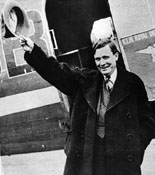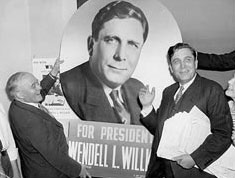Republican Philadelphia
GOP Convention of 1940 in Philadelphia
What happened was the death of 42-year-old "Lizzie," the zoo's oldest elephant. The elephant of course, is the symbol of the Republican Party.
There was a tongue-in-cheek quality about the reporting of Lizzie's demise, but there was truly a dark, ominous cloud, hovering over the Republican gathering and the nation.
The Nazis were blitzing through Europe. France fell just two weeks before the gathering. Britain stood alone. The burning questions facing America was how deeply it should get involved. Would America be dragged into the war?
A crisis usually favors the incumbent. And because of the European crisis, President Franklin Delano Roosevelt, let it be know that he would run for an unprecedented third term if his party "drafted" him. So, no matter who the GOP selected, it would be an uphill fight against an extremely popular president in a time of looming crisis.
The 1940 GOP convention would be nothing like the party's two previous Philadelphia gatherings (1872 and 1900) when there was no contest for the top of the ticket and the only question was the vice presidential spot.

Thomas Dewey
There was no Mark Hanna or Matthew Quay-style "kingmakers" in 1940. It was a wide open convention with a dozen hopefuls. Front-runner were Sen. Arthur A. Vandenberg of Michigan; Sen. Robert A. Taft of Ohio, son of the former president and Manhattan District Attorney Thomas E. Dewey.
Others with a shot at winning the nomination included convention chairman, Rep. Joseph Martin of Massachusetts, publisher Frank E. Gannett of Rochester, N.Y. — who arrived in the city with three circus elephants — and Pennsylvania Gov. Arthur H. James, holding his state's 72 votes. Even ex-President Herbert Hoover had a shot.

Wendell Willkie: the dark horse candidate
But the name and face that dominated the headlines and thoughts when the convention opened on June 24 was unlikely, obscure Wendell L. Willkie of Indiana. He had never before ran for public office; he had only been a Republican for two years and was practically unknown just two months prior to the convention.
The Evening Bulletin was constantly running Gallop polls. Days before the opening of the convention, Gallop showed Willkie skyrocketing in popularity among GOP voters. He had gone from three percent at the start of May to 29 percent in only a month and a half. Dewey had held the lead in the polls for two years. The New Yorker was still the favorite, but had slipped from 68 percent in May to 47 percent as the convention opened.
Party big-shots were aghast at the rise of amateur Willkie, a lawyer and electric utility executive. The newspapers revealed feverish "stop Willkie" movements that would soon burst the candidate's bubble.
Philadelphia had gained the convention with a $200,000 bid. Roosevelt had won the city in 1936, but the Philadelphia Republican machine was still in charge at City Hall.
The site of the convention would be Convention Hall, at 34th and Spruce, which is now abandoned but was less than a decade old in 1940. It could accommodate 15,000; it had a new parking lot and a laughable "air conditioning" system based on blocks of ice and fans. It would be the first televised convention, although practically no one owned a television set; the technology was new and experimental. Mostly, the TV screens served the overflow crowd in the Commercial Museum next door to Convention Hall. However, through a series of relays, pictures managed to travel a record 325 miles to Lake Placid, N.Y.

Throngs of people turn out for the Convention
Organizers had concerns about Philadelphia image as staid and dull. It was understood that police would look the other way as delegates arrived on Sunday. Blue Laws forbidding the sale of booze on the sabbath would be ignored, just as they had when the Democrats met in 1936. To liven things up, there was a condensed Mummers Parade that drew more than 500,000 spectators. A Schuylkill River water festival with fireworks, floats (that floated) races and stunts drew 350,000. Jack Kelly Sr., the city's most famous rower, was conspicuous by his absence. Kelly was, after all, the city's Democratic Party chairman.
There was also a big outdoor dance party and plenty of nightclubs to tempt the visitors. The Latimer Club featured "Gorgeous Girls." The Little Rathskeller at Broad and Spruce had a full bill, including The Four Ink Spots and Grace Brion who "cavorts in futuristic dance."
Public Safety Director James "Shooey" Malone promised tight security with 500 policemen on duty inside Convention Hall. He said "suspicious-looking persons" who can not explain their business would be hauled before magistrates.
But things are rarely dull or totally safe in Philadelphia. The Record reported that 1,000 people, many of them delegates, witnessed "a real-life game of cops and robbers complete with running gunfire" in Center City as cops chased a thief.
More ominous was "a large dynamite bomb with an alarm clock-like device attached to set it" seized at the Communist Workers' School at 1215 Walnut Street."
Things got off to a dull start in Convention Hall but heated to a frantic pitch before the end. The press panned keynote speaker Harold Stassen, the 33-year-old governor of Minnesota. The lobbying for votes was sometime subtle and sometimes rough and tumble. Each day, Taft supporters gave every delegate a carnation. Gannett forces countered by giving out orchids. Willkie took a more direct approach. Although he denied any knowledge of it, the galleries were packed with rabid Willkie supporters who went wild anytime his name was mentioned.

Wendell Willkie campaigning
When Willkie's name was put into nomination "pandemonium" broke out. The Bulletin describes a "deafening roar from the spectators." The floor demonstration was a 20-minute melee as Willkie and anti-Willkie delegates fought over state signs. There was a good deal of shoving and a few noses bloodied before police cooled tempers.
On the first ballot, Dewey was ahead followed by Taft and Willkie. Thereafter, Dewey steadily lost strength while Taft and Willkie picked up votes. On the fourth ballot Willkie was ahead but short of the 501 votes needed for nomination.
"Not since the turbulent 1920 convention which finally led to the nomination of the ill-fated Harding had the Republicans staged such a fierce fight," wrote a Record reporter. "Both candidates (Taft and Willkie) went into the sixth round fighting furiously. The convention floor was the scene of hectic activity as the rival managers dashed back and forth fighting desperately for votes."
On the sixth roll call — 1 a.m. Friday — Willkie finally went over the top.

Franklin D. Roosevelt
The newspapers were filled with profiles on the neophyte politician who had first gained attention by leading "knocked-down and drag-out fights with the New Deal and its Tennessee Valley Authority. . . . A strapping 220 pounds, 6-foot-1 man with piercing blue eyes, black hair which he disdains to keep combed." Willkie had energy, charisma and fresh ideas. His "splendid, resonant voice, particularly suited for radio transmission" was seen as a match for Roosevelt, a master of radio.
The party chose Oregon Sen. Charles L. McNary as Willkie's running mate despite his initial protests. McNary said he had never met Willkie but considered him "an excellent candidate." McNary was seen as the friend of the farmer and a skilled politician.
In the election, Roosevelt overwhelmed Willkie with 54 percent of the popular vote — 38 states to Willkie's 10.



